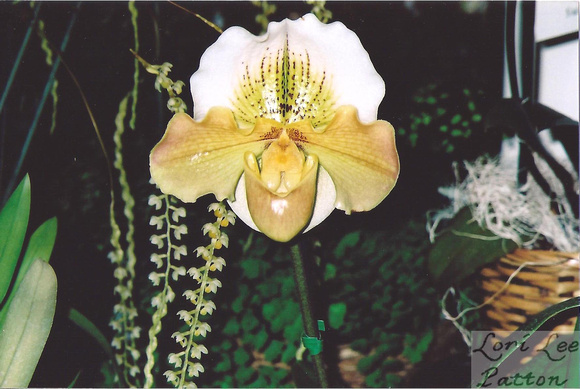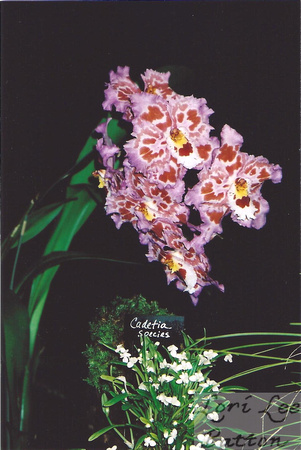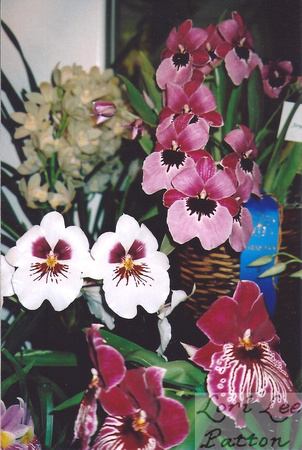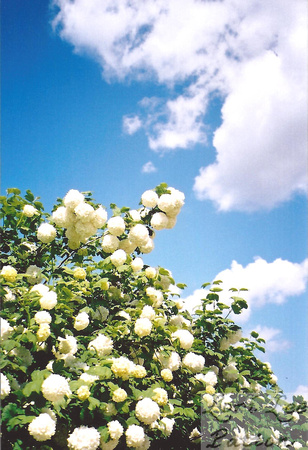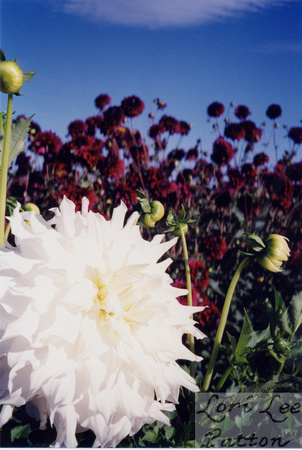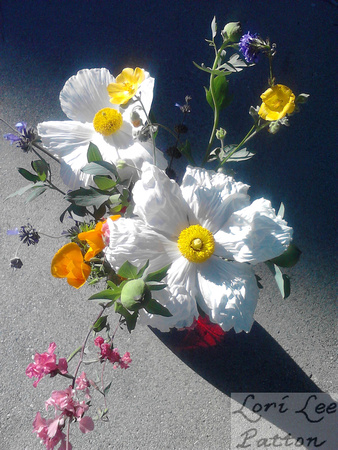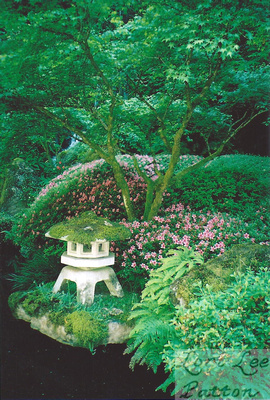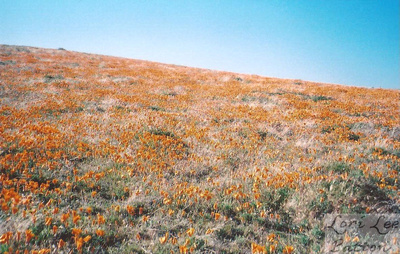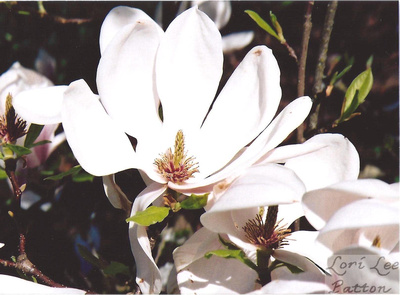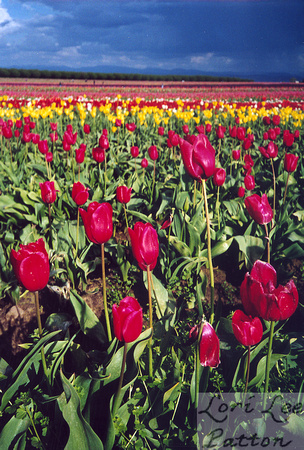Exploring Exotic Orchids
Orchids have always held a certain mystery for me. They are not typical garden flowers and can be rather difficult houseplants to maintain. Although I have been an avid gardener and once boasted over 20 indoor plants, orchids were not among them. It wasn’t until I started working for an advertising agency in Portland, Oregon that I first became acquainted with these unusual flowers. The agency had a florist specializing in orchids bring new arrangements for the office every month. I was fascinated by the wide variety of orchids both in terms of shape and color patterns. Recently, I decided to delve into the botanical history of orchids to reveal the secrets of their exotic beauty. There are approximately 25,000 orchid species with over 155,000 hybrid varieties. To make this mind-boggling number more manageable, I’m going to focus on three genera that I find captivating. The first is the paphiopedilum genus, more commonly known as lady’s slipper orchids. The photo of the yellow and white orchid shown above is one of these specimens. Native to southern Asia, paphiopedilums were named by the German botanist Ernst Hugo Heinrich Pfitzer. Since orchids had been associated with the Greek goddess of love, Aphrodite, whose legendary birthplace was Paphos, Pfitzer incorporated this myth into the genus name. Thus, paphiopedilum combines the Greek words Paphos with pedilon, meaning slipper (lady’s slipper orchids). Distinguishing features of these orchids are their lacquered appearance and unusual color combinations. Also, their lips resemble a pouch or toe of a slipper, hence the name. In the photo above, notice the white sepal with yellow pattern containing brown speckles and a vertical green streak. The mustard petals and lip also have a mottled brown pattern and glossy finish. The intricate design of this flower is like a work of art and lends itself beautifully for photographic enlargements. Caring for lady’s slipper orchids is a challenge, however, as they require nighttime temperatures of around 50 degrees along with 50 percent humidity.
Another orchid that I find particularly lovely is the odontoglossum, native to South America. The photo “Exotic Orchids” shown above features dusty pink blooms with brown and white splotches surrounding yellow columns. The column is the area in the orchid’s center that receives pollination and is what distinguishes orchids from other flowers. Notice the pretty ruffled edges of the petals, which add to its whimsical appearance. These Columbian odontoglossums grow in the Andes Mountains at elevations up to 10,000 feet. Therefore, they require very cool growing conditions with nighttime temperatures around 45 degrees and humidity up to 70 percent to simulate the mountains’ foggy environment. Unless one has a special climate controlled room, it would be difficult to grow these orchids successfully. The small white orchids shown at the bottom of the photo are of the unrelated cadetia species. These are a great example of the diversity of orchids as they are so different from the more well-known varieties. The dainty cadetia flowers also provide an attractive contrast to the showy odontoglossums, as well as a welcome burst of white against the dark background.
My favorite orchids also belong to the odontoglossum tribe but are of the separate miltonia genus. These delightful flowers, shown in the photo “Prize Pansy Orchids” above, first caught my eye when I attended the Oregon Orchid Society’s annual show. They look a lot like pansies – a common garden flower I’ve planted many times – but are more elegant and have fancier patterns. However, while pansies are very easy to grow, miltonias are temperamental. As they also originate from Columbian cloud forests, they require similar climate conditions as odontoglossums. I admire those growers who are able to replicate this environment to raise such beautiful specimens. The pink miltonias, awarded the blue ribbon in the photo, are the hybrid Joyce Goldfarb. All hybrid names are maintained by the Royal Horticultural Society in England. The variety of orchids – one of the world’s largest plant families -- is truly amazing. Due to their particular growing requirements, one of the best ways to enjoy them is by placing some orchid photographs in your home or office. Whether you prefer the cheerful pansy orchids, the lovely lady’s slipper orchids, or the exotic odontoglossums, you will have a bit of beauty to brighten your living space year-round. SourcesJames, I.D. Orchids. Buffalo: Firefly, 2001. Kramer, Jack. Orchids. Ed. Kathryn L. Arthurs. Menlo Park: Sunset, 1977. Potter, Jennifer. Seven Flowers and How They Shaped Our World. New York: Overlook Press, 2014.
Decorating with Winter Whites
Now that the New Year has begun it’s a good time to freshen up our homes with some new décor. Winter whites are a time-honored tradition and enhance any interior from rustic country to sleek urban. Decorating with white throughout your home is both practical and easy! Several tips are provided below along with reasons why white is a proven color to brighten your living space.
Scandinavian countries, especially Sweden, were among the first to popularize white interior design. This arose from the long winters where there was little sunlight. It was necessary, particularly before electricity, to find a way to make the home lighter inside. By whitewashing walls and floors in addition to painting furniture white, the effect was achieved. In fact, various cultures around the world have historically used white. Throughout ancient Greece and Rome, temples and basilicas were fashioned from white marble, in what eventually became known as classical architecture. We can see this legacy today in the White House and other government buildings in Washington, D.C. In eighteenth-century France during the reign of King Louis the XV, the Rococo period emerged featuring the colors of white and gold, depicting the most elegant and decadent style up to that time. White has also been used by cultures for very practical purposes, such as in Mexico and the American Southwest. In these hot regions, dwellings were made of whitewashed adobe to keep cool. As these examples illustrate, white has a fascinating history and its benefits extend far beyond decorating!
White can make a home feel fresh and clean while imparting a simple but elegant look. Another bonus is that white pairs well with any color and works with both traditional and modern décor. In short, you can’t go wrong with white! A good way to get started is with your home’s walls, as they are one of the most visible elements of any room. There are many different shades of white, including creams and ivories. If you want a softer look, choose an off-white color with a slight hint of yellow to bring winter warmth. Then select an accent color that can be used for wallpaper borders and other decorative elements. Blue is an excellent partner for white. This combination comes directly from nature: puffy white clouds against an azure sky or white sea foam on blue waves. Next, select some wall art to enhance your room. Flowers always look lovely and during winter, when they are not in bloom, one of the best ways to include them in your décor is through photographs. Fortunately, there are many white flowers of all shapes and sizes that blend perfectly with a winter white decorating scheme. One of my favorites is the snowball bush as shown in the photo above. The globular white flowers are contrasted by a pretty blue sky while the fluffy clouds add interest and depth to the image.
One of the best areas to decorate with white is the bedroom since it lends an air of peace and serenity. Since childhood I’ve always had white bedroom sets in various styles from colonial to whitewashed country pine. Wool or chenille bedspreads in different creamy shades make a comfortable winter retreat. In warmer seasons, bed coverings may be replaced by crisp cottons or silky satins. Dressing tables and nightstands are good places to display floral photographs, too. An excellent selection for any season is “Snowbound Dahlia,” a gorgeous, pure white flower that grows up to nine inches wide. I took this photo while visiting a dahlia farm in Oregon’s Willamette Valley. As seen in the image below, the blue sky, dark green leaves, and burgundy flowers in the background all serve to make the white dahlia appear even more radiant!
It’s easy to extend the white decorating scheme beyond winter by changing your accent colors. For spring, you may add some yellow around your house to bring the sunshine indoors (see my previous blog post on color therapy). The photo shown below “Matilija Poppy Bouquet” features an eye-catching combination of white and yellow, along with some other spring colors like green and pink. This whimsical poppy is native to California and is sometimes called the fried egg flower because of its center resembling a yolk! The ripples in the petals, light and shadows, geometric arrangement of the bouquet, and contrast of the soft flowers against the hard concrete all contribute to a captivating image. Be sure to look through my Flowers gallery for other white flowers, such as “Magnolia Blossom,” which was featured previously in another of my blog posts.
This winter try decorating with white and see how it lightens and refreshes your living space. Once you have experienced the simple elegance of white, experiment with it throughout the year by trying different accessories and fabrics in your favorite accent colors. Remember white goes with everything so your home will always look great and reflect your own unique style. Now that’s a New Year’s resolution everyone can celebrate!
Sources Hoppen, Stephanie. White on White: Creating Elegant Rooms with Classic Whites. New York: Bulfinch Press, 2000.
Larmoth, Jeanine. Decorating with White. New York: Hearst Books, 1996.
Color Therapy In Home Décor
Colors have always been a source of inspiration and comfort to me. In elementary school, I participated in the Young Author’s Program and wrote a children’s book called “Rainbow Colors.” Ever since then I have sought to surround myself with colors that stimulate positive feelings and create a peaceful environment. In fact, one of the key reasons that I have focused on flower photography is to capture all the beautiful colors found in nature. Not only are colors lovely to behold, but research has also found that they provide important health benefits. One of the easiest ways to achieve these benefits is to choose the right colors for your home décor. Below is a brief description of the history of color therapy, along with modern practical application. Following is a recommendation of three colors that will enhance your living space featuring selected images from this site.
Since ancient times, civilizations have recognized the importance of color to daily life. People are naturally rejuvenated by the warm hues of sunlight and calmed by the cool shades of night. This is directly related to the production of serotonin and melatonin by the brain’s pineal gland. If there is an imbalance in these hormones (as often occurs in winter when there is less daylight), health problems may occur. Ancient Egyptians and Greeks believed that the colors contained in sunlight reflected the divine and influenced various aspects of life. Consequently, they developed treatments using specific colors, including painting rooms in shades beneficial for healing. Color therapy continued in the Middle Ages and Renaissance, especially through the medical treatises of Avicenna and Paracelsus.
From the nineteenth century to the present, modern research methods have confirmed ancient wisdom in color healing. Studies have been conducted to determine how colored light affects blood pressure, arthritis, and depression, among many other ailments. One condition affecting several million people that can benefit from color therapy is seasonal affective disorder (SAD). This results from an increase in melatonin levels due to decreased sunlight in winter. It is more prevalent in northern areas, especially those with prolonged rainy and overcast weather. I experienced this condition myself when I lived in the Pacific Northwest. While exposure to sunlight is the best cure, that is often not possible in such climates. In this situation, surrounding yourself with bright colors may be beneficial. Research has shown that the brain responds not only to sunlight but also to specific colors, which signal the endocrine system to regulate hormones.
One of the best colors to ease the winter doldrums and lift your spirits is yellow. This color represents sunlight and the renewal of the earth in spring. Daffodils are among the first flowers to bloom in February or March and are a sign that spring is at hand. After a long gray winter, I remember how rejuvenated I felt while walking through a field of bright yellow daffodils in Oregon’s Willamette Valley. I took the photo shown above called “Golden Daffodils” to keep a reminder of the promise of spring year-round. Yellow can be used throughout your home, but is particularly effective in family rooms or areas where children play or study because it stimulates the intellect and promotes joy. For those interested in incorporating Feng Shui in home decor, it is important to note that yellow is considered to be the central element. As in Western tradition, yellow is believed to represent the earth and facilitate good health. By hanging a picture such as “Golden Daffodils” in a central area of your home, you will be able to harness the positive energy of yellow in accordance with Eastern and Western design principles.
Another color useful in achieving a peaceful and relaxed home environment is green. As it is adjacent to yellow on the color wheel, green is a harmonious partner in creating a balanced color scheme. Like yellow, green also represents springtime through its association with plants and fertility. In addition, it symbolizes luck and good fortune: in Western culture as it relates to Irish shamrocks, leprechauns, and four-leaf clovers; and in Eastern tradition where it embodies the powerful green dragon. In decorating terms, green is a receding color, which means that it makes a room appear larger. It is an excellent color to use in small spaces and has been shown to alleviate feelings of claustrophobia. Green is also the easiest color for the eye to see since no retinal adjustment is needed to focus on it. Incidentally, this is the reason that traffic lights are green for passing through intersections and change to red to indicate a stop. As green also aids mental recall and concentration, it is ideally suited for home offices or studies. The above photograph “Lush Japanese Garden” is a lovely way to include green in your wall décor. I took this picture at the height of spring and it features many shades of green found in the maple leaves, ferns, moss, and other vegetation. The pink azaleas provide a pleasing accent color.
Besides green, the other neighbor to yellow on the color wheel is orange. Since it works in harmony with yellow, orange provides many of the same benefits, such as stimulating joy and bringing warmth into your home. However, as orange is created from yellow and red, it contains additional attributes. Orange offers energy and vitality represented by the fire element in Feng Shui, but is often more suitable than red in home décor because it is not as overpowering. Orange is associated with creativity in Eastern and Western traditions. Therefore, it is a great companion to yellow for use in children’s playrooms or other areas within your home that are devoted to artistic pursuits, such as crafting or sewing. For me the greatest representation of orange in nature is the California poppy found throughout the west coast region. I took the photograph “California Poppy Field” shown above at the state reserve located in the Antelope Valley. During a short time in early spring, the usually brown hillsides are transformed into spectacular, orange fields reminiscent of Oz. By placing this image of bright poppies in your home, especially a foyer, you can create a welcoming and cheerful atmosphere for all who enter.
Color therapy in home décor is an easy, effective way to use a holistic healing method that has been practiced since ancient times. Cheerful, stimulating colors, such as yellow and orange, balanced with the calming hues of green are an excellent way to get started! After experimenting with these, you may want to branch out to the contrasting colors of red, blue, and purple. Soon you will create a home environment with all the colors of the rainbow sure to enhance your life throughout every season!
Sources
Dee, Jonathan, and Lesley Taylor. Beginner’s Guide to Color Therapy. New York: Sterling, 2003.
Graham, Helen. Discover Color Therapy. Berkeley: Ulysses Press, 1998.
Magnolias: Prehistoric Blooms in Modern Times
My interest in magnolias began as a child living off of Magnolia Blvd. in Los Angeles’ San Fernando Valley. There was a large southern magnolia tree in my backyard, which dropped its creamy, fragrant petals throughout the hot summer months. Those petals, deliciously scented and soft, were always out of my grasp until they floated down to the ground. I had no idea then that magnolias are believed to be one of the most ancient flowering plants, dating back millions of years. Following is a brief account of these amazing trees and how they have survived for eons. Currently, magnolias are native to two areas of the world: the eastern Americas, from Canada south to Brazil, and eastern Asia, including China and Japan. However, they were originally much more widespread, encircling the Arctic regions before the first ice age. Fossils of magnolias have been discovered in Idaho dating back to the Miocene epoch 17 to 20 million years ago. Even more research suggests that magnolias were part of the ancient plant life that lived on Laurasia before it was divided into North America and Eurasia. This combination of climate change and continental drift accounts for the unusual distribution of the species. Modern distribution of magnolias in gardens around the world began in 1687 when British missionaries to the American colonies sent back plants to London. A sweet bay magnolia in Virginia was the first to travel across the Atlantic followed by the southern magnolia around 1730. Magnolias were named after Pierre Magnol, a prominent French botanist in the late 17th century. Next the Asian magnolias were collected in China and Japan and taken to Britain around 1790. While the American magnolias are evergreen and produce large white flowers continuously through the summer, the Asian species are deciduous and flower profusely in spring. They also resemble lilies and appear in a variety of colors besides white, including pink and purple. These Asian magnolias were so popular in Europe that horticulturalists quickly set about hybridizing. The most important of these hybrids were the soulangeanas, created by Etienne Soulange-Bodin in 1820, a French cavalry officer for Napoleon. Since these robust beginnings, magnolia hybrids continue to be produced by breeders around the world. Magnolias are currently found throughout America and are the state flower of Louisiana and Mississippi. Southern magnolias like the one at my childhood home continue to flourish around Los Angeles. Asian magnolias, which are better adapted to cooler climates, are commonly seen in the Pacific Northwest. The photograph “Magnolia Blossom” shown above was taken at Hoyt Arboretum in Portland, Oregon. The arboretum contains a superb collection of Asian magnolias that bloom in spring. From their first appearance millions of years ago to the thousands of different varieties available today, it seems magnolias have discovered the secret to longevity: an exquisite beauty that belies their strong endurance. Sources Gardiner, Jim. Magnolias: A Gardener’s Guide. Portland: Timber Press, 2000. Tudge, Colin. The Tree: A Natural History of What Trees Are, How They Live, and Why They Matter. New York: Three Rivers Press, 2006. Tulips in America The first time I set out to photograph the tulip fields in Oregon’s Willamette Valley was a milestone for me. Captivated by the endless kaleidoscope of tulips, I decided that flower and nature photography would be my specialty. Since these tulip fields were so important to my artistic calling, I started to research the history of tulips in America and made several fascinating discoveries. Tulips were first brought to America in 1624 by Dutch colonists, who settled in New Amsterdam (modern-day Manhattan). The flowers were so popular that by 1760, fifty different types of tulip bulbs were being sold in Boston. George Washington and Thomas Jefferson were among the tulip fanciers. More Dutch immigrants arrived in the early nineteenth century, establishing communities in Michigan and Iowa. America soon grew into such a strong market that tulip growers in Holland sent traveling salesmen to the U.S. to take bulb orders. This was quite the marketing endeavor as the salesmen spent over two months sailing back and forth across the Atlantic and up to six more months traveling through the States to visit American nursery owners. The spread of tulip popularity in early America was due largely in part to the mass plantings of tulips in public parks and gardens. A consortium of Dutch growers donated millions of bulbs to landscape parks in New York, San Francisco, and St. Louis. The Dutch were so successful with their sales efforts that by 1910, the U.S. was importing a million dollars in bulbs. While Holland still dominates the world tulip bulb market, America has grown to be the fourth largest bulb producer. The U.S bulb growers are located in the Pacific Northwest and some northeastern states, where there is a favorable climate for tulips. Visiting one of these tulip fields makes it easy to see why tulips are the most popular bulbs in America. The flowers come in all colors of the rainbow and brighten everyone’s spirit. I named the photograph above “Tulip Paradise” because for me there is no place I’d rather be than surrounded by these cheerful and vibrant blooms. Sources Crockett, James Underwood. Bulbs, The Time-Life Encyclopedia of Gardening. Alexandria: Time-Life Books, 1978. Pavord, Anna. The Tulip. New York: Bloomsbury, 1999. Potter, Jennifer. Seven Flowers And How They Shaped Our World. New York: Overlook Press, 2014.
© Lori Lee Patton
|
